Room 1
This room, which extends across the palace from Corso Vannucci to Via della Gabbia, formed part of the extension that was carried out in 1317-26 to accommodate the Priori delle Arti. It was known as the Sala Maggiore, and must have been the most prestigious part of the palace complex. The walls were covered with frescoes in 1378, but no trace of these survives.
This room was divided in 1472, when the back part (i.e. towards Via della Gabbia) became the Udienza Nuova (new audience chamber). This room was damaged by fire in 1506 and its wooden ceiling was destroyed. The current stone vaults of Room 1 were built in 1513.
Deposed Christ (1236)
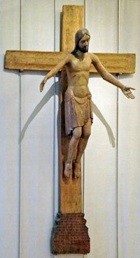
This work is closely related to the so-called Tivoli Deposition (ca. 1220), which is still preserved in the Duomo, Tivoli. Similar and broadly contemporary works were executed elsewhere in central Italy, although most of them have been dispersed or lost. The figure of Christ would have originally formed part of a group that included other actors in the deposition: the Virgin, St John the Evangelist, and probably Joseph of Arimathea and Nicodemus. The heavily restored figure of the Virgin remains in the original location,
San Felice Dossal (ca. 1250)

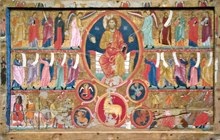

This dossal, which is the autograph work of the Maestro di San Felice di Giano, came from the Abbazia di San Felice, Giano dell' Umbria (30 km from Perugia). It was removed to the local gallery in 1922 and subsequently to its present location.
In the centre of the dossal, Christ sits in judgment in a mandorla, with censing angels to the sides. Full-length figures occupy two registers to each side:
-
✴the top register contains figures of:
-
•to the left:
-
-St Andrew;
-
-St Simon;
-
-St Paul; and
-
-the Virgin: and
-
•to the right;
-
-St John the Baptist;
-
-St Peter;
-
-St James; and
-
-St Philip; and
-
✴the middle register contains figures of prophets.
Tondi below the figure of Christ contain the Lamb of God and the symbols of the Evangelists, with scenes from the martyrdom of St Felix to the sides.
Marzolini Triptych (ca. 1275)
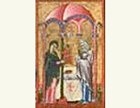
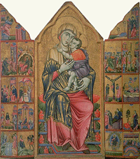
The triptych, which is the autograph work of the Maestro del Trittico Marzolini (or Maestro del Trittico di Perugia), came from the Templars’ church of San Bevignate. It depicts:
-
✴the Madonna and Child in the central panel;
-
✴scenes from the life of Christ on the left; and
-
✴scenes from the Passion on the right.
The fact that the Templars commissioned the work is evidenced by an altar cloth in the scene of the Presentation at the Temple, which is decorated with their distinctive red cross.
The Templars were accused of heresy in 1307, and the Franciscans of San Francesco al Prato were appointed to act as Inquisitors at San Bevignate. Their goods were confiscated at this point and the triptych later found its way to the Franciscan nunnery of Sant’ Agnese. The nuns probably commissioned the later paintings of SS Francis and Clare on the outer sides of the covers.
In 1907, when the triptych was exhibited in Perugia, it was recorded as the property of Monsignor N. Marzolini. It passed to the gallery shortly thereafter.
Farneto Dossal (ca. 1290)

This panel, which is the autograph work of the Maestro del Farneto, came from the Franciscan Convento di Farneto, outside Perugia and passed to the gallery in 1863.
The dossal depicts a half-length figure of the Madonna and Child at the centre, with two scenes from the Passion of Christ on each side.
Santa Giuliana Dossal (1291)
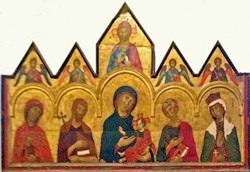
This dossal, which is signed and dated by inscription, is the only known work by Vigoroso da Siena, and is the earliest surviving work in Perugia by a "foreign" artist. Its iconography suggests that came from the nunnery of Santa Giuliana, albeit that it belonged to the Collegio della Mercanzia in 1879, the date at which it entered the gallery.
The dossal depicts the Madonna and Child with SS Mary Magdalene, John the Baptist, John the Evangelist and Juliana (who is identified by inscription). Christ in Glory is depicted above the Madonna and Child, and an angel is depicted above each of the saints.
The format of the dossal is intermediate between early dossals (in which the figures occupied a single field) and later polyptychs (in which the figures occupied separate panels). Thus, while it is made up of horizontal rather than vertical planks:
-
✴carved arches separate the figures in the lower register, and
-
✴the figures in the upper register are arranged in five distinct gables cut into the upper plank.
Processional Crucifix (ca. 1272)
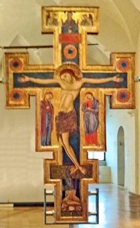
-
✴One side has an inscription HIC NAZARENUS; REX IUDEORUM; REX GL]ORIA]E in the upper panel, while the lower panel is blank.
-
✴On the other side (illustrated here), both panels are painted:
-
•the upper panel contains a small half-length figure of the praying Virgin between angels, above a smaller copy if the above inscription; and
-
•the lower panel contains a small kneeling figure of St Francis kissing the right foot of Christ. This figure was over-painted at some point to remove a small identifying inscription and the Franciscan habit, but these original features were revealed in a recent restoration.
Tabernacle (late 13th century)
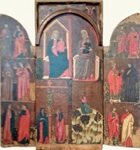
-
✴The central panel contains four scenes:
-
•St Anne and the baby Mary enthroned;
-
•the Madonna and Child;
-
•the Crucifixion with the Virgin and St John the Evangelist; and
-
•Christ’s agony in the Garden of Gethsemane.
-
✴Each of the side panels has pairs of saints in three registers:
-
•SS Peter and Paul; a monk and an angel; and SS Catherine of Alexandria and Cecilia on the left; and
-
•SS John the Baptist and Laurence; SS Augustine and the Blessed Sperandius (identified by inscriptions); and St James and another Apostle on the right.
Two angels above the central panel can still be seen when the doors of the tabernacle are closed.
Marble Fragments from the Fontana Maggiore (1278)

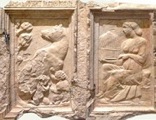
Rome Romulus and Remus suckled by a wolf
and their mother, Rea Silvia
These sculptures by the father and son Nicola and Giovanni Pisani came from the Fontana Maggiore. They comprise:
-
✴the personification of Rome (from the middle basin of the fountain); and
-
✴the related pair of reliefs of Romulus and Remus suckled by a she-wolf and of their mother Rea Silvia (from the lower basin).
They were damaged in the uprising of 1859 because they exemplified Perugia's erstwhile allegiance to the papacy, and were removed during the restoration of the fountain in 1948.
Three Water Carriers (1278)
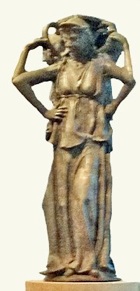
The group was cast as a single piece, perhaps by Rubeus, the artisan who cast the basin itself. The design is sometimes attributed to Nicolò and Giovanni Pisano.
Two Griffins and Two Lions (late 13th century)
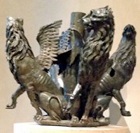
Fragments from the Fontana Minore (1278-81)


The Fontana Minore, which stood which stood “in foro” (on the probable site of the Roman forum, in modern Corso Vannucci), was commissioned from Arnolfo di Cambio, probably in 1277 and is his earliest documented work. It seems that he did not arrive in Perugia until early 1281, when he was paid for 24 days work. This suggests that the design of the fountain and the execution of the associated sculptures was carried out in Rome, and that Arnolfo visited Perugia for the installation.
The fountain ceased to function (possibly through an interruption in the water supply) in 1301 and was demolished in 1308. The history of the few fragments that survived the demolition is unclear until they were collected together in the period 1872-1968. These fragments, which are now in the Galleria Nazionale, comprise:
-
✴two seated jurists, one of which is headless (and the other is illustrated here);
-
✴two reclining figures in deep relief; and
-
✴a relief of a thirsting woman at the well (illustrated here).
As set out above, the cast figures (ca. 1274) of a griffin and a lion that were used in the annual procession on the feast of St Herculanus were placed on detachable mountings on the fountain soon after its installation.
Frescoes from Santa Giuliana (ca. 1380)
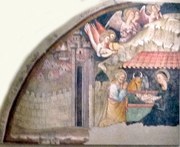
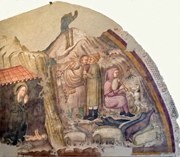
These two frescoes, which were detached before 1878 from a lunette in the nunnery of Santa Giuliana, depict:
-
✴the Nativity; and
-
✴the Adoration of the Shepherds.
Frescoes from San Francesco al Prato (14th century)
These frescoes, which were re-discovered on the altar wall of the crypt of San Francesco al Prato in 1888 and detached in the 1920s, are the autograph works of the so-called Maestro di San Francesco al Prato.
-
✴Those on the altar wall depicted the Crucifixion with the Virgin and St John the Evangelist, with four Franciscan saints to the sides:
-
•SS Louis of Toulouse and francis on the left; and
-
•SS Clare and Antony of Padua on the right.
-
They were detached in 1933 and are now in the deposit of the gallery.
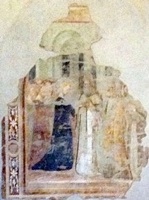
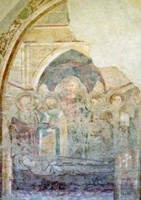
-
✴Those on the side walls depict:
-
•the Marriage of the Virgin; and
-
•the Dormition of the Virgin.
-
They were detached in 1921-7 and are now exhibited here.
Room 1a
This small room, which is opposite and to the right of the entrance to the gallery, was built over Via dei Priori in 1506 (after the fire in the Udienza Nuova mentioned above) to link the Cappella dei Priori (now Room 21) to the Sala Maggiore.
The entrance to this new room from the Sala Maggiore was opened using one of the windows in what had originally been an external wall.
Christus Patiens with St Francis (1272)
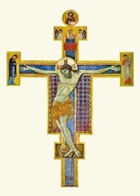
The Crucifix depicts the agony of the dying Christ:
-
✴The grieving Virgin and St John the Evangelist flank the outstretched arms of Christ;
-
✴a small half-length figure of the praying Virgin between angels terminates the vertical arm of the cross, with Christ the Redeemer in a tondo above; and
-
✴the stigmatised St Francis kneels at the foot of the cross, contemplating the wounds in the feet of Christ.
Panels from a polyptych (ca. 1272)
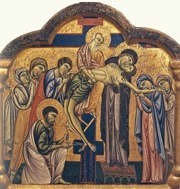
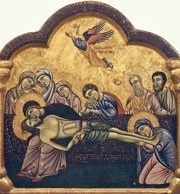
Deposition of Christ Lamentation
These six panels (including the two illustrated above) belong to a set of ten that are attributed to the Maestro di San Francesco. They were recognised in 1961 to have belonged to the earliest double-sided altarpiece of which we are aware. In 1982, Dillian Gordon (see the page on the artist) demonstrated that they constituted less than half those that were originally mounted in a monumental frame. She suggested that the altarpiece had originally been on the high altar of San Francesco al Prato. The altarpiece and the Crucifix illustrated above probably both belonged to the same prestigious commission. In 2001, Donal Cooper (see the page on the artist) pointed out that the need for a double-sided altarpiece on the high altar probably arose because the friars had a choir behind it, despite the fact that such an arrangement was uncommon in similar churches in other parts of Italy until the 16th century.
Dillian Gordon reconstructed this remarkably wide polyptych as follows:
-
✴The panels facing the friars in the choir of the church would have been (from left to right):
-
•a saint and/or prophet, probably St Francis (lost);
-
•two scenes from the Passion (lost);
-
•a saint and/or prophet, probably the prophet Jeremiah (lost);
-
•a central scene, probably of the Crucifixion (lost);
-
•the prophet Isaiah;
-
•the Deposition of Christ (Perugia, illustrated here);
-
•the Lamentation (Perugia, illustrated here); and
-
•St Antony of Padua (Perugia).
-
✴The panels facing the congregation in the nave would have been (from left to right):
-
•the stigmatised St Francis, whose Gospel is open at Galatians 2:19, “I have been crucified with Christ” (Perugia);
-
•SS Simon and Bartholomew (Metropolitan Museum, New York);
-
•St James Minor (National Gallery, Washington);
-
•St Andrew (only identified as such when a restoration in 1994 described him as the saint who evangelised “Patras”) (Perugia);
-
•a central scene, probably of the Madonna and Child (lost); and
-
•four other panels, including:
-
•St Peter (Perugia); and
-
•St John the Evangelist (National Gallery, Washington).
(In this list, “Perugia” indicates a panel that is now in the gallery).
The polyptych was replaced in 1403 and subsequently dismembered. The panels, which were probably moved initially to the sacristy, were subsequently dispersed.
-
✴The three panels that are now in America and the panel of St Peter passed to the Arciconfraternita della Pietà del Camposanto Teutonico, Rome at some point and were on-sold in 1921.
-
✴The panel of Isaiah was discovered at San Francesco, Assisi in 1919 and is now in the Museo del Tesoro di San Francesco.
-
✴All the panels that are now in the Galleria Nazionale, except the panel of St Peter, were acquired from local collectors over the five decades up to 1932.
-
✴The panel of St Peter found its way to a private collection in Brussels and was acquired by the Galleria Nazionale in 2001.
Room 2
This room was built above Via dei Priori in ca. 1330 and was referred to in 1380 as the "ante-cappella" (now the first part of Room 4).
Madonna and Child with angels & saints (early 14th century)
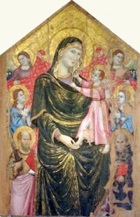
-
✴St Paul stands to the left. The signature on the sword of St Paul reads: “Marinus P” (Marino da Perugia): this artist is usually identified as the miniaturist Marino d’ Elemosina, who was documented in 1309, and/ or with Marino di Oderisio, who was the head of the painters’ guild in 1318.
-
✴The monk to the right is sometimes identified as St Peter Celestine, because the abbey was known as the Celestina. In fact, while it is true that St Peter Celestine (who reigned as Pope Celestine V for a few months in 1294 and was canonised in 1313) did form a Benedictine congregation, there is no evidence that San Paolo di Valdiponte ever belonged to it. It was known as the Celestina only after 1585, by which time it belonged to the Congregazione di San Giorgio in Alga; the word Celestina derived from the canons' blue habits.
Madonna and Child (early 14th century)
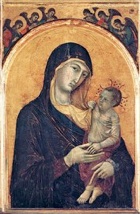
A recent restoration has revealed that it was originally the central panel of a polyptych: this would have been one of the first polyptychs in Umbria. The commission was broadly contemporary with that of Duccio's polyptych for the Dominicans of Siena (the so-called Polyptych 28 in the Pinacoteca Nazionale, Siena - ca. 1306). In the Perugian panel, the Madonna points to the hands and feet of the Child, prefiguring His Crucifixion, while six praying angels look down from spandrels above the fictive semicircular frame. The naturalistic representation of the figures is closely related to that in Duccio’s famous Maestà (1308-11) from the Duomo, Siena.
Madonna and Child (ca. 1310)
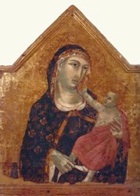
Montelabate Polyptych (ca. 1315)
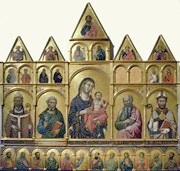
This polyptych, which is signed by Meo di Guido da Siena, came from the high altar of the Abbazia di Santa Maria di Valdiponte, Montelabate, outside Perugia. It was dismembered in the late 18th century, after which time the panels were displayed separately in various parts of the church. Most of the panels entered the Accademia di Belle Arti in 1810: however, the central panel and the predella remained in the church until 1863, when most of the surviving panels were reunited in the gallery. The panel of St Peter passed into private ownership at some point, and was acquired by the gallery in 1968.
The polyptych seems to have been inspired by Duccio’s contemporary work, including his polyptych for San Domenico, Perugia (see above).
-
✴The central panel depicts the Madonna and Child with two prophets above above and Christ the Redeemer in the gable.
-
✴The side panels, each of which has an angel in the gable, depict:
-
•St Gregory, with SS Martha and Catherine of Alexandria above;
-
•St Peter, with SS Antony Abbot and Benedict above;
-
•St John the Evangelist, with the saints above missing; and
-
•St Emilian, with SS Agnes and Mary Magdalene above.
-
✴The predella depicts the twelve apostles.
Madonna and Child (1325-30)
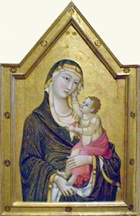
Room 3
This small room is formed by the curtain walls of the tower of Cola di Benvenuto Servitori, which was incorporated into the palace in ca. 1330.
Processional Cross (ca. 1290)
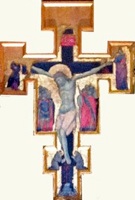
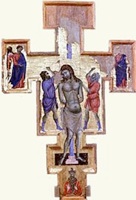
This double-sided processional cross, which is attributed to the Maestro della Croce di Gubbio, entered the gallery from the Accademia di Belle Arti in the 19th century.
-
✴One side depicts the Crucifixion, with the Virgin and St John the Evangelist to the sides, soldiers on the apron and SS Francis and Antony of Padua at the foot of the Cross.
-
✴The other side depicts (much less conventionally) the flagellation of Christ, with angels to the sides and a bishop saint below.
The presence of Franciscan saints at the foot of the Cross and the presence of the Flagellation of Christ on the reverse suggests that it was originally commissioned for a confraternity of penitents under Franciscan auspices.
Galleria Nazionale: Sala Podiani and Sala Conferenze Rooms 1-3 Room 4
Rooms 5-6 Rooms 7-10 Rooms 11-16 Room 17 Rooms 18-20 Cappella dei Priori
Rooms 22-28 Rooms 29-32 Rooms 33-40 Deposit
Return to Museums of Perugia.
Return to Walk I.



